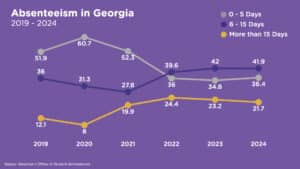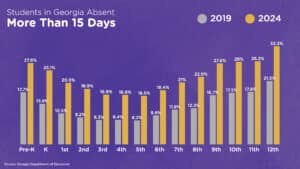Present and Accounted For: Georgia’s Strategy to Tackle Chronic Absenteeism
By Sarah Torian
When a high-performing student began missing school, the teachers and school staff in Dublin City Schools took action. After repeated calls to the home went unanswered, they knocked on the door to check on the student and her family and ensure they were okay. They learned that the child’s mother had recently been released from jail and hadn’t been able to secure a new job yet. There was no food in the house and they were struggling with basic needs. The school quickly rallied around the family, engaging several community partners who helped address the family’s needs. With that wraparound support, the student is attending school regularly again — and thriving.
This story depicts just one aspect of the shift in approach to reducing chronic absenteeism that the district has adopted in recent years. Efforts include a robust data-tracking system that enables school leaders to flag students with frequent absences before they become chronically absent; family engagement strategies such as phone calls and home visits by social workers to identify and address barriers to attendance; efforts to ensure a positive and welcoming school climate; and collaboration with local businesses and nonprofit programs whose support helps to address underlying causes of absenteeism related to transportation, health, and more.
“This is heavy work, but it is the right work,” stresses Dr. Frederick C. Williams, the superintendent of Dublin City Schools and 2024 Georgia Superintendent of the Year. “Engaging students and families is a non-negotiable for our school staff. Coming out of COVID, we had to meet students’ needs in order to promote attendance. If there is something causing a student to miss a lot of school, we want to address that need or those reasons, but it begins with understanding that missing school is symptomatic of something else.”
As a result of this comprehensive, tiered intervention approach, the district’s chronic absenteeism (including excused and unexcused absences) – which had spiked to 45% in 2020 — dropped to 8% by February 2025.
Dublin City Schools was not alone in seeing significant spikes in chronic absenteeism in the wake of the pandemic. Statewide, the percentage of students absent more than 15 days doubled from 12% in 2019 to 24% in 2022. But Dublin City does stand out for its ability to reverse that concerning nationwide trend. Statewide, absenteeism has persisted with nearly 22% of students across the state missing more than 15 days of school during the school year in 2024.
One of the most concerning aspects of these persistent spikes is their prevalence among the state’s younger learners. More than 20% of students in Pre-K, kindergarten and first grade missed more than 15 days of school in 2024, meaning significant numbers of Georgia children are missing out on the opportunity to learn foundational skills in early literacy and numeracy that are critical for future school success.
This crisis of absenteeism stretches far beyond Georgia with rates of chronic absenteeism almost doubling nationwide and remaining far above pre-pandemic levels.
GGR Cabinet Members Respond to Absenteeism
At the spring 2024 convening of the Get Georgia Reading (GGR) Cabinet, this cross-sector group of state and local leaders agreed that the issue of absenteeism was ripe for awareness building and collective action. Attendance was not a new issue for GGR. After analysis by the Georgia Department of Education in 2014 found that student learning is negatively impacted after just six absences — and with data showing that four out of every 10 students were missing six or more days of school — state and community leaders prioritized nurturing positive learning climates that improve student attendance.
“We’ve had a focus on attendance since the start of the campaign — especially given the research demonstrating the negative impact after the sixth day of absence,” explained Arianne Weldon, director of the GGR campaign.
With post-pandemic data showing that two-thirds of Georgia students were now missing more than six days of school, the GGR Cabinet formed a subcommittee of members and launched an effort to examine and disaggregate attendance data, explore factors that might be contributing persistent rates of absenteeism, and to look for evidence-based solutions. The group, including state leaders from Georgia Partnership for Excellence in Education, the Georgia Board of Education, and Technical College System of Georgia (TCSG) and local/regional leaders representing the Cobb Collaborative, Dublin City Schools, and the Central Savannah River Area RESA, met every two weeks between late April and October under the leadership of Dr. Garry McGiboney, executive director of Sharecare and longtime deputy superintendent of the Georgia Department of Education.
Over the course of six months, the partners dug into this critical issue and what it means for Georgia’s children. They engaged national experts at Attendance Works who shared insights and effective strategies drawn from the organization’s decade-plus history of tackling this issue at the state and local level. They reviewed and discussed research reports and articles on attendance and absenteeism. And they disaggregated Georgia data by grade, race, sex, socioeconomic status, English proficiency, disability status, and migrant status.
Recognizing the limitations of quantitative data in understanding what might be contributing to these persistent spikes in absenteeism, TCSG developed and disseminated an online survey to parents of school-age children to gain a deeper understanding of their perceptions about attendance and the barriers they face in ensuring their children attend school regularly. Over the summer, TCSG surveyed more than 100 parents, asking about children’s interest in going to school and how the parents felt about different levels of absenteeism; their schools’ communication with them about attendance; the impact of physical and mental health on student attendance; and more. These survey findings were shared with the subcommittee to inform their thinking and planning.
The subcommittee engaged Neighborhood Nexus (NN) to help them answer the question: What would be the impact on 3rd grade ELA assessment outcomes if student attendance improved by 5 percent? A research model developed by NN found that a 5 percent decrease in chronic absenteeism would lead to a 6.6 percent increase in 3rd grade ELA proficiency in Georgia. Inspired by that analysis, the subcommittee scoured articles and reports to identify effective approaches that were being advanced in Georgia communities — like the efforts in Dublin City — and in states and communities across the country. Drawing on what they saw in these areas, they compiled a list of recommendations to serve as a resource list of effective practices for schools, school districts, and community partners to consider as they seek to respond to student absenteeism.
“The subcommittee intentionally shifted its focus from the problem to the possibilities — asking not just, ‘What’s wrong?’ but also, ‘What’s working, and how can we build on it?,’ explained McGiboney. “From that perspective, the subcommittee identified effective practices already in place and used them as the foundation for meaningful, sustainable recommendations that school districts of any size could adopt.”
With support and feedback from the other subcommittee members, McGiboney synthesized the research, data, and insights into a detailed and actionable report in late 2024. After presenting the report to the full Get Georgia Reading Cabinet in November 2024, the subcommittee has been sharing insights with leaders across the state.
Georgia Partnership for Excellence in Education cited the report in its 2025 Top Ten Issues to Watch report. Subcommittee members have presented findings, insights, and recommendations from the report to various audiences, including presentations by McGiboney and Williams at convenings of the Georgia Association of Educational Leaders and the First District Regional Education Service Agency. The report was also shared with Georgia State Senator John Kennedy’s staff, who drew on a section recommending that Superior Court judges create Student Attendance Committees to support the drafting of Senate Bill 123, which passed both the House and Senate in 2025. In addition, the Get Georgia Reading Campaign communications subcommittee is developing a set of tools and resources for state and local leaders to use in building awareness about the importance of everyday student attendance and informing collective action to remove barriers and boost attendance.
Spurred by the report and the growing awareness of the issue of chronic absenteeism, the Georgia legislature passed SB 123 during the 2025 legislative session. The bill prevents schools from expelling students who are chronically absent and tasks school climate committees with creating policies to decrease chronic absenteeism. Schools and districts with chronic absenteeism rates above a certain threshold will also be required to create attendance review teams to help students who are missing too much school.
“We’ve underestimated both the importance of attendance and the complexity of attendance,” McGiboney reflected. “Any effective and sustainable solutions must consider both.”
Access the Get Georgia Reading Cabinet Student Attendance Subcommittee Report and Recommendations
Contact:
Arianne Weldon
Arianne@gafcp.org


